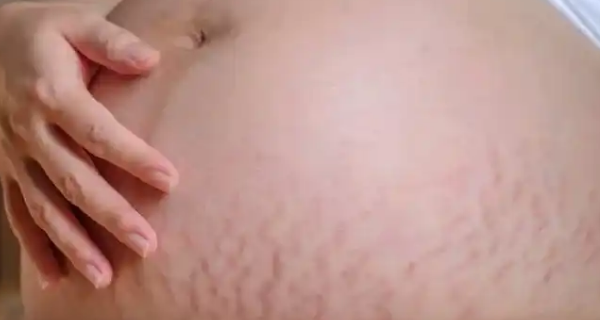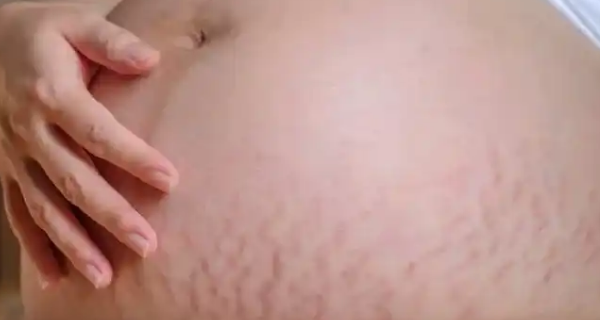

Striae gravidarum, the medical term for stretch marks, are visible indentions in the skin that appear during pregnancy. Red, purple, or silver are all possibilities for their color. The most common areas for stretch marks to appear are:
stomach
chest
hips
bottom
thighs.
Stretch marks are more frequent in pregnant women, but they can appear at any time in life. For some, they’re more prone than others to them. You’re more likely to have stretch marks if your mother, father, grandparents, or other close blood relatives have them. The danger of stretch marks can be reduced and the markings you already have can be treated, even if you’re genetically predisposed to them.
1. Control your weight
Maintaining a healthy weight is one of the best ways to avoid stretch marks, whether you’re pregnant or not. The rapid weight growth that occurs when a person gains weight can cause the skin to tear, resulting in stretch marks. Rapid weight loss might also leave you with stretch marks. During growth spurts, such as puberty, some people notice stretch marks on their skin. Others, such as bodybuilders, become aware of them as a result of significant weight gain as a result of training or the use of anabolic steroids. Working to slow down the rate at which your body changes might be your best option. Keep your weight under control by eating healthily and exercising regularly. A trip to the doctor to determine the cause of any fast weight gain or loss may be in order.
2. Stay hydrated
It may be possible to maintain your skin hydrated and soft by drinking a sufficient amount of water. Stretch marks are less likely to appear on soft skin than on dry skin. Men should drink 104 ounces of water per day, and women should drink 72 ounces. This is the current recommendation from the Institute of Medicine. You may actually increase your risk of developing stretch marks by drinking caffeinated beverages, such as coffee, Coffee drinkers should drink lots of water, herbal tea, and other caffeine-free beverages in order to maintain a healthy hydration level.
3. Include vitamin C in your diet
Keeping your skin strong and supple relies on the role that collagen plays. Stretch marks may be prevented with the use of this product, but wrinkles may also be reduced. Collagen production necessitates the use of vitamin C. This powerful antioxidant can be found in a wide variety of colorful fruits and vegetables. Among the best fruits to eat for vitamin C intake are oranges and lemons.
4. Soak up some vitamin D
Vitamin D deficiency has been linked to an increased risk of developing stretch marks. Maintaining a high vitamin D level may minimize your risk of developing stretch marks, according to preliminary findings. Exposure to the sun is the simplest method of obtaining vitamin D. Bread, cereal, and dairy products such as milk and yogurt are also regularly fortified with vitamin C.
5. Treat fresh stretch marks when they appear
Stretch marks can’t be completely avoided, but they can be minimized over time to make them less obvious. Your doctor or dermatologist can help you determine the best course of action if you have recently developed stretch marks. If you have new stretch marks, your doctor may be able to identify the cause and recommend the best treatment choices.
Risk factors
Stretch marks are more common in some persons. Factors that increase a person’s chance of getting cancer include:
in the position of a woman
having a history of stretch marks running in my family
being a fat person
being a mother
becoming fat and thin at a rapid rate
The use of corticosteroids in this situation
augmenting one’s breasts
Cushing’s disease and Marfan syndrome are examples of hereditary disorders.
Stretch marks in pregnancy
When a woman is pregnant, she is more likely to notice stretch marks. Stretch marks appear on 50 to 90% of pregnant women before giving birth, according to research. So, how are pregnancy stretch marks different from those of other people?? Maybe. Pregnancy hormones may increase your risk of developing stretch marks, according to some doctors. Hormones may increase the amount of water in the skin, causing it to loosen and eventually tear more easily. There’s a lot of room for argument on this topic. Stretch marks usually appear around the sixth or seventh month of pregnancy for the majority of women. Most women in a recent BMC Pregnancy and Childbirth research reported using an anti-stretch mark cream. The most often used product by one-third of the women surveyed was Bio-Oil. However, stretch marks appeared on 58.5% of the women who took this oil. Pregnant women can avoid stretch marks by gaining weight gradually and steadily throughout their pregnancy. With the help of your doctor, you can develop a diet and exercise regimen that keeps you from gaining too much weight while still providing you with the nutrients you and your unborn child require. The good news is that stretch marks will eventually fade if you get them during pregnancy. When the red or pink color ages, it will turn to a pale silver or white color.
Treatment
There are several treatments that can minimize the appearance of stretch marks, but preventing stretch marks is tough.
Retinoid cream
Vitamin A is the source of retinoid cream, a topical medicine. Applying retinoids may improve the appearance of your skin, especially if your stretch marks are still relatively new at the time of application. As a result, your markings begin to blend in with the rest of your skin as a result of using this lotion. If you are pregnant or breastfeeding, talk to your doctor about this medication because most doctors agree that topical retinoids should not be taken during pregnancy or while breastfeeding because their risk-benefit ratio is still unclear.
Laser therapy
A third approach for decreasing stretch marks is the use of laser therapy. Your skin’s collagen and elastin can grow more quickly if you use lasers to encourage their production. It’s up to your doctor to assist you decide which sort of laser therapy is best for you.
Glycolic acid
Stretch marks can also be treated using glycolic acid lotions and chemical peels. Many of these therapies are too expensive, even if your insurance does cover them. They help to reduce the visibility of existing stretch marks, but they have little effect on the formation of new ones.
Outlook
It’s common for stretch marks to fade away over time. It’s difficult to keep them at bay, and there aren’t any magic cures out there, either. Stretch mark prevention is a common claim made by cosmetics and other personal care products, although these claims are frequently unsupported by scientific evidence. They may not assist, but in most circumstances they won’t hurt. Weight loss, hydration and healthy eating can all help reduce the appearance of stretch marks. Seeking treatment right away is also a good idea. If you observe an increase in stretch marks or if they cover a significant portion of your body, contact your doctor. To find out what’s causing them, you may want to see a doctor.









